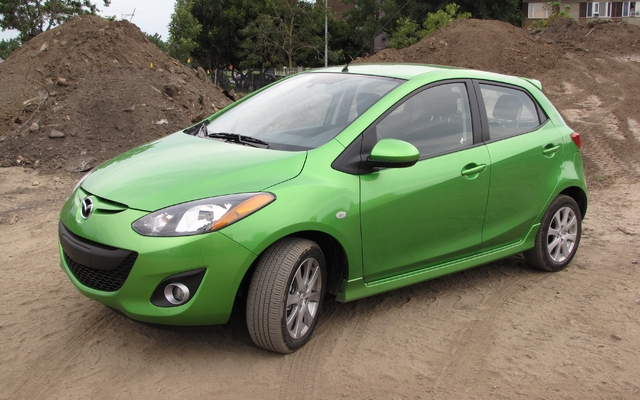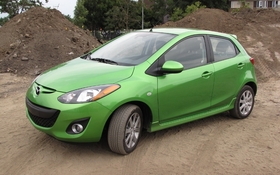Ford Fiesta vs. Mazda2: The little cousins go head-to-head
It is a well-known fact that the Ford Fiesta and Mazda2 share many components. However, their engines and transmissions are a little different from one another. The expression "little cousins" is more accurate on the Old Continent, where these two economy vehicle icons are equipped with more similar drivetrains than in North America.
In Canada, this resemblance leads to tighter competition, particularly in terms of their technical specs. Remember that the Ford Fiesta available here is built in Mexico, whereas the Mazda2 comes from Japan. What’s more, the American comes as a sedan or hatchback, while the Japanese car only comes as a five-door hatchback. The latter also comes as a three-door hatchback or sedan in certain European and Asian markets.
High-end versions
For this comparative test drive, I opted for the high-end versions of each rival’s five-door hatchback model. In other words, I got the Ford Fiesta SES and the Mazda2 GS. It’s important to know that the Fiesta SES is more expensive than its Japanese opponent. The Fiesta SE is actually more similar to the Mazda GS. These two vehicles are built on the same platform and benefit from several active and passive safety features, the kind you would find on more expensive cars. In this regard, the Fiesta is a little more generous, especially when it comes to protecting the driver’s knees.
Two little five-doors
In North America, there is a diehard group of drivers that love hatchbacks. Ford and Mazda are both counting on them to bolster sales of the Fiesta and Mazda2. The main advantage of this type of vehicle is that it gives you more options than a conventional sedan.
In terms of aesthetics, both cars are pretty with a very nice design. The Fiesta looks more modern and a little more aggressive, whereas the Mazda2 smiles with its new front end and more fluid and upward swooping lines.
Roomier than you’d think
Both vehicles boast the fact that they can seat five, but the truth is that they offer a good amount of space for four average-sized passengers. Accessing the rear seats is tighter on the Fiesta due to its narrower door openings.
The driving position is quite good on both vehicles, even for long drives – though the firmness of the Fiesta’s leather seats can be a little trying. In both cars the bench seat is firm and less comfortable, especially in the Fiesta.
The Ford Fiesta’s dashboard is more elaborate and eye-catching that that of the Mazda2, but in both cases it is functional and ergonomic. The instrumentation is more high-tech on the Ford, particularly the voice-activated SYNC system. As for the Mazda2, its instrumentation is easier to read and the controls are more user-friendly. Both vehicles offer multi-functional steering wheels with radio controls, cruise control, and other multimedia functions.
The soundproofing is impeccable on the Japanese car, and this is true all over. It is also very good on the American car, though the 16-inch wheels are rather indiscreet. Also, the soundproofing is less generous around the fenders. However, when you fold the seats down, the soundproofing on both vehicles takes a hit when you drive over certain surfaces at more than 105 km/hr.
Storage and cargo space
The Fiesta and the 2 offer storage space in the console and between the two bucket seats. I preferred those on the Mazda2, which offers a little more storage space overall.
The minimal cargo space is somewhat more generous on the Fiesta, which gives you 435 litres compared to 377. With the bench down, both vehicles offer the same size cargo hold. Unfortunately, neither offers a flat surface – quite the contrary!
Road Test
One engine against the other
The Ford Fiesta features a more powerful engine: a 1.6-litre four-cylinder Duratec that delivers 120 horsepower and 112 lbs-ft of torque at 5,200 rpm. The Mazda2’s engine, a 1.5-litre, produces 100 horsepower and 98 lbs-ft of torque at 4,000 rpm. For four-cylinder engines with an average level of engine displacement, neither of these engines is very noisy, though the Mazda2’s engine is a little more discreet. Under the hood, the Fiesta’s engine presentation is archaic, with all its components visible. Both take regular gas, and the Fiesta features the capless fuel system.
Two awesome manual gearboxes
In both cases, I tested the manual five-speed transmission. The shifter on the Fiesta is in the console, whereas in the Mazda2 it is in the central panel. I really enjoyed both manual gearboxes, the gears are not set too far apart and the friction point is easy to find – particularly in the Fiesta. However, the transmission on the Japanese car is more gentle and pleasant. The Fiesta also comes with a five-speed automatic, whereas the Mazda2 makes do with a four-speed automatic gearbox.
More than decent performance
Although the Ford Fiesta offers an additional 20 horses, both cars offer very similar performances. The Mazda2 owes this success to its light weight and its maximum torque attained at 4,000 rpm (compared to 5,000 rpm for the American car).
Both vehicles are very good on gas and respectful of the environment, in the city and on the highway. After spending part of the week splitting my driving time between the city and the highway, I took each of these vehicles for a long drive. The Mazda2 took me to Waterville via Dummondville and Longueuil. I held a constant speed of 115 km/hr over 420 km. Then I took the Ford Fiesta to Lévis and back, for a total of 520 km completed at the same cruising speed. Here are the results...
Mazda2:
Average fuel consumption: 7.8 l/100 km or 36 mpg
Highway fuel consumption: 6.2 l/100 km or 46 mpg
Ford Fiesta:
Average fuel consumption: 8.5 l/100 km or 33 mpg
Highway fuel consumption: 6.3 l/100 km or 45 mpg
On the highway at a constant speed, these vehicles offer nearly identical fuel economy. However, for everyday city driving, the Mazda2 is more economical.
Very different handling
The Fiesta features rack and pinion power steering with variable assistance, which makes it slightly firmer and more precise than the Mazda2’s steering. The suspension on both vehicles is rather firm as well. This is especially felt by the rear seat passengers. With 16-inch tires, the Fiesta is firmer ride than the Mazda2. The ventilated discs and drum brakes on both vehicles do an honourable job. They benefit from an electronic brake-force distribution (EBD) and neither vehicle has any problem being stable during emergency braking. With 195/50R16 all-season tires, the Ford Fiesta SES adheres to the road much better than the Mazda 2 GS with its 185/55R15 tires. Note: outfitting the Mazda2 with winter tires is a little more difficult than it is for the Fiesta.
Test drive results
Advantages:
Ford Fiesta
More aggressive appearance
Good fuel economy
More dynamic handling
A little more cargo space
Available as a sedan
Mazda2
More comfortable
An economical choice
More agile in the city
Smooth manual transmission
Better pricing
Disadvantages:
Ford Fiesta
More challenging access to rear seats
Poor rear visibility
Prices climb quickly
Mazda2
Automatic with four speeds only
Power is only OK in some circumstances
More limited choice of winter tires
Summary
The Mazda2 was tested first. I really enjoyed the test drive and I thought the Ford Fiesta would have to work extra hard to match it.
Imagine my surprise when I discovered that the Fiesta was just as interesting as the Mazda2 to drive – and even superior in some regards.
I will admit that I went in with a soft spot for the Mazda2, and this test drive has done nothing to change that. However, the American car pleasantly surprised me, and I would not be ashamed to buy one for myself – quite the contrary. Unfortunately, the Ford name is enough to turn some people off.












